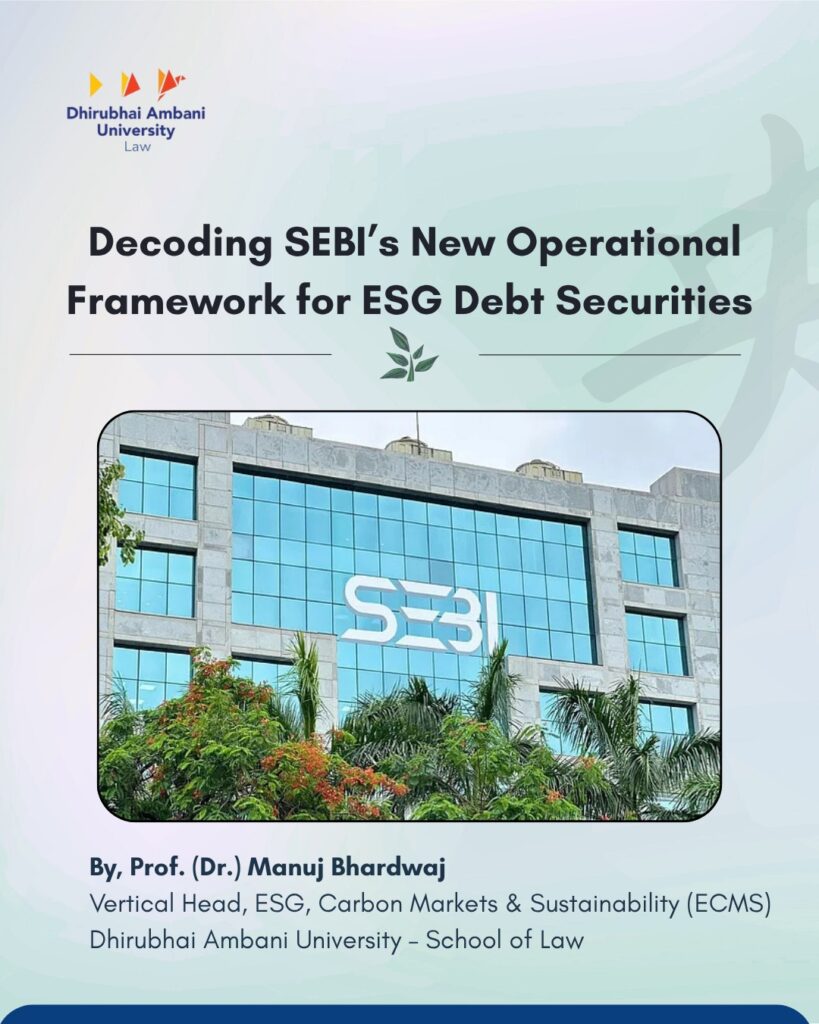By Dr. Manuj Bhardwaj [Head – ESG, Carbon Markets & Sustainability [ECMS] Vertical, Dhirubhai Ambani University – School of Law]
India is entering a new era of sustainable finance regulation. With the Securities and Exchange Board of India (SEBI) unveiling its much-anticipated operational framework for ESG debt securities, the country is now structurally closer to closing the funding gap for Sustainable Development Goals (SDGs). This framework, which came into effect from June 5, 2025, is a strategic move that institutionalizes responsible finance by formally recognizing social bonds, sustainability bonds, and sustainability-linked bonds (SLBs) under a clear regulatory lens.
As someone who works at the intersection of climate policy, legal innovation, and market development, I see this as more than a technical guideline it is a foundational step in democratizing access to sustainable finance and embedding transparency, accountability, and purpose into India’s capital markets.
Why This Framework Matters
SEBI’s initiative doesn’t exist in a vacuum. It arrives at a time when investors are demanding greater assurance that their capital is not just generating returns but also driving real-world impact. By mandating initial and continuous disclosures, third-party verification, and alignment with internationally recognized frameworks, SEBI is effectively creating a level playing field for issuers and boosting investor confidence.
For instance, issuers will now need to articulate clearly:
- The social objectives behind projects financed through social bonds;
- The process for determining project eligibility;
- The methodology for tracking the deployment of proceeds;
- And the breakdown of financing versus refinancing.
These requirements are not just compliance checkboxes, they shape how organizations design, execute, and report on sustainable projects. This operational rigor will help weed out greenwashing, encourage credible innovation, and, importantly, signal to global investors that India is serious about ESG.
A Turning Point for ESG Legal Education
At the Dhirubhai Ambani University – School of Law, we see this moment as pivotal. As India’s first law school built specifically with working professionals in mind, our mission is not only to interpret the law but also to anticipate where the law and the market is going.
Our upcoming Executive Development Programme in ESG, Carbon Markets & Sustainability, launching on June 23, 2025, is purposefully designed to unpack frameworks like SEBI’s and equip professionals with the tools to understand, implement, and lead in this evolving ecosystem. This framework will be embedded into our curriculum, and taught by a cross-section of legal scholars, sustainability practitioners, and capital market experts.
What will this look like in the classroom?
- Simulation modules where learners will design an ESG bond offer document based on SEBI’s latest disclosure norms;
- Case clinics analyzing both successful and failed social bond issuances globally;
- And live sessions with regulators, investors, and ESG rating agencies, offering real-time insights into how such frameworks are operationalized on the ground.
Moreover, as we gear up to launch our Master’s Programs in ESG, Carbon Markets & Sustainability in September 2025, SEBI’s operational framework will form a key part of our core curriculum on sustainable finance law and compliance. Understanding the legal architecture around ESG bonds will no longer be a niche skill but will be essential for anyone operating in corporate governance, financial services, climate finance, or public policy.
Building Capacity for a Sustainable Bharat
What makes this framework especially promising is its potential to build institutional capacity across sectors such as private, public, and not-for-profit. SEBI rightly recognizes that social and environmental impacts are deeply interconnected, and that India’s transition to a greener economy must also be a just and inclusive transition.
As educators, our role is to bridge policy and practice. With frameworks like these, we now have concrete regulatory texts that can serve as living documents in our classrooms, allowing learners to engage not just theoretically, but practically and strategically.
India’s sustainable future will be shaped by the decisions made today, not just in boardrooms and ministries, but also in classrooms like ours, where the next generation of legal and ESG leaders are being forged.

